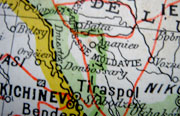 There are signs that the “frozen” conflict between the Republic of Moldova and the “Dniestrian Moldovan Republic” may be thawing. At a meeting in Moscow on September 22nd, the parties agreed to resume official consultations on (to quote the communiqué) the “permanent meeting on political questions in the framework of the negotiation process on the Transdniestrian settlement.” This followed a meeting in early September in Bad Reichenhall where the parties agreed to cooperate in areas such as telecommunications, removing trade barriers, and unblocking passenger and freight railway connections between Chisinau and Odessa via Transdniestrian.
There are signs that the “frozen” conflict between the Republic of Moldova and the “Dniestrian Moldovan Republic” may be thawing. At a meeting in Moscow on September 22nd, the parties agreed to resume official consultations on (to quote the communiqué) the “permanent meeting on political questions in the framework of the negotiation process on the Transdniestrian settlement.” This followed a meeting in early September in Bad Reichenhall where the parties agreed to cooperate in areas such as telecommunications, removing trade barriers, and unblocking passenger and freight railway connections between Chisinau and Odessa via Transdniestrian.
So, after several years, is the Transdniestrian settlement process back on track?
Key Conclusions
After a five-year hiatus, the parties have agreed to resume official dialogue on the settlement of the Transdniestria situation. Lithuania’s Chairmanship of the OSCE this year has been discreet yet determined in getting the talks back on track. The fact that Ireland, as Chairman in 2012, has indicated that it will appoint a Special Envoy for Moldova is a good sign of its commitment to moving the process forward. A rare meeting between Moldovan Prime Minister Vlad Filat and Transdniestrian “President” Igor Smirnov in Bad Reichenhall shows that the parties are willing to talk.
However, not all stars are aligning. Upcoming elections in Transdniestria and Russia could politicize what is already a sensitive issue. The fact that there is still no President of Moldova is also a complicating factor. Bearing these factors in mind, the September agreements in Bad Reichenhall and Moscow may well have been a high water mark in terms of political compromise rather than the beginning of a major breakthrough.
If top-down diplomacy is unlikely in the near future, at least the way is now open for expert-level dialogue. At the Bad Reichenhall meeting, the parties agreed to General Regulations on the Expert (Working) Groups on Confidence Building Measures and Development of Cooperation. These expert-level working groups can be a place to hammer out practical cooperation across a number of fields, and can act as confidence-building measures in themselves.
Analysis
The Republic of Moldova has been a divided country almost since its independence twenty years ago. On September 2, 1991, the Supreme Soviet of Transdniestria adopted its own constitution, and on December 1, 1991 the independence of the “Dniestrian Moldovan Republic” was approved by a referendum.
Despite the fact that no state officially recognizes Transdniestria’s independence, it has managed to exercise de facto control over its territory. Over the past twenty years, several attempts have been made to settle the conflict. However, after Moldova’s rejection of the Russian-sponsored Kozak Memorandum in November 2003, the settlement process broke down. Since 2006, there have been no formal discussions in the so-called 5+2 negotiations framework (which includes Moldova and Transdniestria with Russia, Ukraine and the OSCE as mediators and the EU and US as observers).
The agreement in Moscow of September 22nd enables the resumption of talks in the context of the 5+2 negotiating framework. In order to be successful, the Moldovan government will need to contemplate a new power-sharing agreement with Tiraspol. The Transdniestrian leadership will not want to settle for less than the Kozak memorandum, and will seek international guarantees like respect for property rights and respect for Moldova’s neutrality.
Moscow could exert considerable leverage on Tiraspol, not least because of the massive debt that Transdniestrians owes to Gazprom for gas consumption. However, there has to be something in it for Russia, such as better relations with the European Union, and guarantees of Moldova’s neutrality. Ukraine, which neighbors Transdniestria, can also exert leverage through more effective border control (in cooperation with the EU Border Assistance Mission–EUBAM) and as future OSCE Chairmanship-in-Office in 2013.
Lithuania, as 2011 OSCE Chair, deserves credit for getting the process back on track. Ireland, as in-coming Chair, will be appointing a dedicated special envoy for Moldova and a separate trouble shooter for the other conflict situations (Georgia and Nagorno-Karabakh). The fact that they have split the functions suggests that Moldova will get special attention. A new Head of the OSCE Mission to Moldova (who is usually, but not automatically, American) will have to come to speed quickly in order to build on the good work done by the outgoing Ambassador Philip Remler.
The European Union has considerable leverage which it has yet to exert. It is working closely with the Government of Moldova to raise its legislation and practices to EU standards. It is also holding out the possibility of visa and trade liberalization, and it is assisting Moldova to ensure effective border control through EUBAM. Furthermore, it is making a major investment (€41 million over three years) in confidence-building measures in Moldova.
However, as part of the reform process of the European Union External Action Service, there is no longer an EU Special Representative to Moldova. This is something the EU should reconsider, as it has done in the South Caucasus. The EU should also make clear to Chisinau that the integration of Moldova is vital for Moldovan integration with the EU, and not just vice versa.
At a time when tensions are returning to Kosovo; when the situation remains tense in Nagorno-Karabakh; and when there is almost no dialogue over Abkhazia and South Ossetia, the resumption of the Transdniestrian settlement process offers a glimmer of hope that at least one of Europe’s “frozen” conflicts can be resolved.




